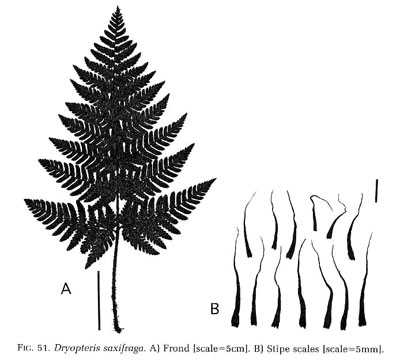| Dryopteris saxifraga | ||
|
Etymology
Latin: saxum, a rock + frango, to break. Because it grows among the rocks, the thought might have been that it actually split the rocks when it grew.
Description
Rhizome: erect, branching, giving rise to few fronds.
Frond: 40 cm high by 15 cm wide, evergreen, at least in warmer climates, persistent stipe bases, monomorphic, blade/stipe ratio: 2:1. Stipe: grooved, straw-colored, brown and thickened at the base, scales black-brown, vascular bundles: 3-7 in a c-shaped pattern. Blade: 2-pinnate pinnatifid at the base, quickly less above, ovate-triangular, dull, mixed scales on rachis, some hairlike, smaller ones bullate; costa scales smaller, very bullate. Pinnae: 12 to 14 pair, subopposite; costae grooved above, continuous from rachis to costae; margins sinuate, slightly turned under; veins embossed on the upper surface. Sori: round, in 2 rows on the pinna, usually one per pinnule on the outer half, indusium: reniform, 1 mm, at a sinus, sporangia: brownish. Culture
Habitat: among rocks, moist cliffs in high mountains.
Distribution: Japan, Manchuria, Korea, northeastern China.
Hardy to -25�C, USDA Zone 5.
Synonyms
Polystichum varium (L.) C. Presl., misapplied Dryopteris varia (L.) Kuntze var. saxifraga (H. It�) H. Ohba |
|
|
Notes
Compare to D. bissetiana which it differs from in being a smaller plant, with shorter stipes, browner scales, pinnae closer spaced, and dull blades
Compare to D. bissetiana which it differs from in being a smaller plant, with shorter stipes, browner scales, pinnae closer spaced, and dull blades
